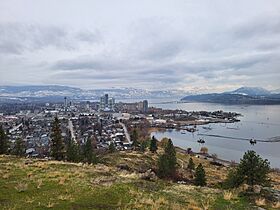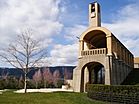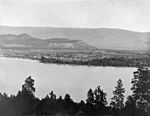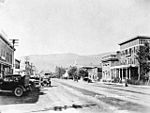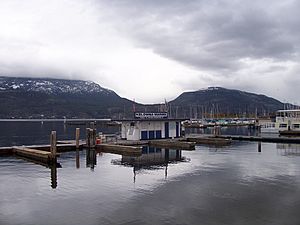Kelowna facts for kids
Quick facts for kids
Kelowna
|
|||||
|---|---|---|---|---|---|
| City of Kelowna | |||||
|
From top, left to right: Downtown Kelowna from Knox Mountain Park, the peaks of Central Okanagan, Mission Hill Winery and Bell Tower, the William R. Bennett Bridge on Okanagan Lake, Okanagan Lake near Rotary Beach Park
|
|||||
|
|||||
| Nickname(s):
Orchard City, K-Town, Sun City
|
|||||
| Motto(s):
"Fruitful in Unity"
|
|||||
| Country | Canada | ||||
| Province | British Columbia | ||||
| Regional district | Central Okanagan | ||||
| Settled | 1879 | ||||
| Incorporated | May 5, 1905 | ||||
| Government | |||||
| • Type | Elected city council | ||||
| • Body | Kelowna City Council | ||||
| Area
(2021)
|
|||||
| • City | 211.85 km2 (81.80 sq mi) | ||||
| • Metro | 2,904.86 km2 (1,121.57 sq mi) | ||||
| Elevation | 344 m (1,129 ft) | ||||
| Population
(2021)
|
|||||
| • City | 144,576 | ||||
| • Density | 682.445/km2 (1,767.52/sq mi) | ||||
| • Metro | 222,162 | ||||
| • Metro density | 76.47942/km2 (198.0808/sq mi) | ||||
| Gross Metropolitan Product | |||||
| • Kelowna CMA | CA$11.3 billion (2020) | ||||
| Time zone | UTC−08:00 (PST) | ||||
| • Summer (DST) | UTC−07:00 (PDT) | ||||
| Forward sortation area |
V1P, V1V – V1Z, V4T
|
||||
| Area code(s) | 250, 778, 236, 672 | ||||
| GNBC Code | JAFUV | ||||
Kelowna (pronounced kə-LOH-nə) is a city located on Okanagan Lake in the Okanagan Valley of British Columbia, Canada. It's the main office for the Regional District of Central Okanagan. The name Kelowna comes from an Okanagan word that means "grizzly bear."
Kelowna is the third-largest city area in British Columbia, after Vancouver and Victoria. It's also the biggest city in the interior of the province. The city itself covers about 211.85 square kilometers. In 2020, the estimated population for the wider Kelowna area was over 222,000 people, with about 142,000 living in the city proper. To help with growth, the city council has been working on a plan to build taller buildings, especially in the downtown area. One Water Street, a 36-story building, is currently the tallest in Kelowna. Even taller buildings are planned for the future!
Other towns nearby include West Kelowna across Okanagan Lake to the west, Lake Country and Vernon to the north, Peachland to the southwest, and Summerland and Penticton to the south.
Contents
- Kelowna's Past: A Look at History
- Kelowna's Geography and Natural Beauty
- Exploring Kelowna's Neighbourhoods
- Kelowna's Economy and Industries
- Kelowna's Population and People
- Getting Around: Transportation in Kelowna
- Local Services and Support
- Fun Places and Attractions in Kelowna
- Culture and Sports in Kelowna
- Learning in Kelowna: Education
- Famous People from Kelowna
- Sister Cities
- Freedom of the City
- Images for kids
- See also
Kelowna's Past: A Look at History
We don't know the exact dates of the first settlements, but people started moving into this area about 9,000 years ago. The Indigenous Syilx people were the first to live here and still do today.
The first European to settle in Kelowna was Father Charles M. Pandosy, a French Catholic missionary, who arrived in 1859. He called the place "L'anse au sable," which means "Bay of Sand," because of the sandy shoreline. Kelowna officially became a city on May 4, 1905.
In May 2005, Kelowna celebrated its 100th birthday! That same year, construction began on the new five-lane William R. Bennett Bridge. This bridge was built to replace the old three-lane Okanagan Lake Bridge. It was part of a plan to help with traffic, especially during the busy summer tourist season. The new bridge was finished in 2008.
Important Moments in Kelowna's History
- On July 3, 1877, George Mercer Dawson was the first geologist to visit Kelowna. Geologists study the Earth's rocks and history.
- On August 6, 1969, a sonic boom from an air show caused a lot of damage. A pilot accidentally flew too low and broke the sound barrier. This caused about a quarter-million dollars in broken glass and injured at least six people.
- The winter of 1986 was the last time Okanagan Lake completely froze over. The Royal Canadian Mounted Police even rescued an SUV that had tried to drive across the ice and fell through!
- In the 2000s, Kelowna built Skye at Waterscapes, a 26-floor residential tower. It was the tallest building between the Lower Mainland and Calgary at the time.
Wildfires in the Kelowna Area
The Kelowna area has experienced several wildfires over the years. These fires can be very serious, sometimes forcing people to leave their homes for safety.
- In August 2003, a large fire called the Okanagan Mountain Park Fire destroyed 239 homes. About 30,000 residents had to leave temporarily. Many old railway bridges of the historic Kettle Valley Railway were also burned, but they have since been rebuilt.
- In July 2009, wildfires near West Kelowna destroyed many hectares of forest and some buildings. About 17,000 residents were evacuated.
- Other fires have also led to evacuations, like a 200-hectare fire in September 2012 that destroyed 7 buildings in Peachland, and a 340-hectare fire in July 2014 that caused 3,000 people to evacuate.
Kelowna's Geography and Natural Beauty
Famous Landmarks
Kelowna is home to many beautiful natural landmarks:
- Mission Creek
- Bellevue Canyon
- Layer Cake Hill
- Pinnacle Rock
- Gallagher's Canyon
- Crawford Falls
- Knox Mountain
- Myra Canyon
- Mission Creek Falls
- Black Knight Mountain
- Maude-Roxby Wetlands
- Lake Okanagan
Kelowna's Climate: Weather Patterns
Kelowna has a unique climate with four distinct seasons. It has dry, hot, and sunny summers, and cold, cloudy winters. The weather station is at the Kelowna International Airport, which is higher up than the city center. This means the airport usually has slightly more rain and cooler nights.
The large Okanagan Lake helps keep the winter weather milder. However, very cold air from the Arctic can sometimes reach the valley for short periods. The coldest temperature ever recorded in the city was -36.1°C on December 30, 1968.
December and January are often the cloudiest months because of "valley cloud." This happens when warmer air from the lake rises above colder air, trapping clouds in the valley for weeks. But if you drive up into the nearby mountains, you can often find bright sunshine above the clouds!
Summers in Kelowna are usually very hot and sunny, with daytime temperatures often going above 32°C. The hottest temperature recorded at the airport was 39.5°C on July 24, 1994. Heat waves, where temperatures stay above 30°C for weeks, are common in July and August. The city gets about 380 millimeters of rain each year, with most of the snow falling in December and January. June is usually the wettest month.
Kelowna is known for having very calm winds. It has the highest percentage of "calm" wind observations for any major city in Canada. This means it's not often very windy! Kelowna's average high temperature stays above freezing every month of the year, which is rare for an inland Canadian city.
Weather Facts:
- Driest Year (1952): 186 mm of precipitation
- Wettest Year (1996): 541 mm of precipitation
- Warmest Year (1998): Average temperature of 11.4°C
- Coldest Year (1955): Average temperature of 5.6°C
- Highest Temperature Ever: 41.0°C (August 1998)
- Lowest Temperature Ever: -36.1°C (December 1968)
| Climate data for Kelowna International Airport, 1981–2010 normals, extremes 1899–present | |||||||||||||
|---|---|---|---|---|---|---|---|---|---|---|---|---|---|
| Month | Jan | Feb | Mar | Apr | May | Jun | Jul | Aug | Sep | Oct | Nov | Dec | Year |
| Record high humidex | 13.0 | 14.5 | 21.1 | 28.0 | 37.0 | 42.3 | 46.4 | 45.6 | 34.9 | 26.7 | 20.6 | 13.9 | 46.4 |
| Record high °C (°F) | 14.8 (58.6) |
17.2 (63.0) |
20.8 (69.4) |
28.1 (82.6) |
34.4 (93.9) |
39.5 (103.1) |
39.5 (103.1) |
39.3 (102.7) |
35.0 (95.0) |
26.8 (80.2) |
20.6 (69.1) |
14.5 (58.1) |
39.5 (103.1) |
| Mean daily maximum °C (°F) | 0.8 (33.4) |
3.6 (38.5) |
10.1 (50.2) |
15.5 (59.9) |
20.2 (68.4) |
24.2 (75.6) |
27.9 (82.2) |
27.6 (81.7) |
21.7 (71.1) |
13.4 (56.1) |
5.6 (42.1) |
0.7 (33.3) |
14.3 (57.7) |
| Daily mean °C (°F) | −2.5 (27.5) |
−0.9 (30.4) |
4.1 (39.4) |
8.4 (47.1) |
12.8 (55.0) |
16.6 (61.9) |
19.5 (67.1) |
19.1 (66.4) |
13.9 (57.0) |
7.3 (45.1) |
1.6 (34.9) |
−2.6 (27.3) |
8.1 (46.6) |
| Mean daily minimum °C (°F) | −5.8 (21.6) |
−5.3 (22.5) |
−2.0 (28.4) |
1.3 (34.3) |
5.4 (41.7) |
9.1 (48.4) |
11.1 (52.0) |
10.6 (51.1) |
5.9 (42.6) |
1.3 (34.3) |
−2.4 (27.7) |
−5.9 (21.4) |
1.9 (35.4) |
| Record low °C (°F) | −31.7 (−25.1) |
−28.3 (−18.9) |
−22.2 (−8.0) |
−9.4 (15.1) |
−4.2 (24.4) |
−1.1 (30.0) |
2.6 (36.7) |
0.6 (33.1) |
−6.1 (21.0) |
−15.7 (3.7) |
−28.4 (−19.1) |
−36.1 (−33.0) |
−36.1 (−33.0) |
| Record low wind chill | −39.7 | −33.0 | −20.4 | −9.8 | −5.4 | −0.6 | 0.0 | 0.0 | −7.3 | −18.2 | −36.3 | −37.6 | −39.7 |
| Average precipitation mm (inches) | 31.0 (1.22) |
19.0 (0.75) |
21.6 (0.85) |
29.1 (1.15) |
40.2 (1.58) |
45.9 (1.81) |
37.2 (1.46) |
32.1 (1.26) |
32.4 (1.28) |
29.2 (1.15) |
36.7 (1.44) |
32.6 (1.28) |
386.9 (15.23) |
| Average rainfall mm (inches) | 8.9 (0.35) |
10.0 (0.39) |
16.9 (0.67) |
28.3 (1.11) |
39.2 (1.54) |
45.9 (1.81) |
37.2 (1.46) |
32.1 (1.26) |
31.7 (1.25) |
29.1 (1.15) |
24.4 (0.96) |
7.6 (0.30) |
311.3 (12.26) |
| Average snowfall cm (inches) | 26.9 (10.6) |
10.8 (4.3) |
4.8 (1.9) |
0.8 (0.3) |
0.0 (0.0) |
0.0 (0.0) |
0.0 (0.0) |
0.0 (0.0) |
0.0 (0.0) |
0.1 (0.0) |
13.6 (5.4) |
32.0 (12.6) |
89.0 (35.0) |
| Average precipitation days (≥ 0.2 mm) | 13.9 | 10.3 | 10.5 | 10.9 | 12.9 | 12.0 | 9.2 | 8.5 | 8.7 | 11.3 | 14.4 | 14.1 | 136.6 |
| Average rainy days (≥ 0.2 mm) | 5.6 | 6.2 | 8.8 | 10.7 | 12.2 | 12.0 | 9.2 | 8.5 | 8.3 | 11.3 | 11.0 | 4.2 | 107.8 |
| Average snowy days (≥ 0.2 cm) | 10.0 | 5.6 | 2.4 | 0.6 | 0.0 | 0.0 | 0.0 | 0.0 | 0.0 | 0.1 | 4.7 | 11.0 | 34.5 |
| Average relative humidity (%) | 76.4 | 65.2 | 48.8 | 39.8 | 40.0 | 39.3 | 35.6 | 36.2 | 42.2 | 55.6 | 70.6 | 75.7 | 52.1 |
| Mean monthly sunshine hours | 39.4 | 80.9 | 148.5 | 191.0 | 238.2 | 244.9 | 297.8 | 281.6 | 216.2 | 124.5 | 50.9 | 35.1 | 1,948.9 |
| Percent possible sunshine | 14.8 | 28.5 | 40.4 | 46.3 | 49.9 | 50.2 | 60.5 | 62.8 | 56.9 | 37.2 | 18.6 | 13.9 | 40.0 |
| Source: Environment Canada | |||||||||||||
Exploring Kelowna's Neighbourhoods
Kelowna is divided into ten main areas, each with many smaller neighbourhoods.
Main Neighbourhoods in Kelowna
- Belgo
- Benvoulin
- Black Mountain
- Braeloch
- Central City
- Clifton
- Crawford
- Dilworth Mountain
- Downtown
- East Kelowna
- Ellison
- Glenmore
- North Glenmore
- Kettle Valley
- KLO
- McKinley Landing
- Midtown
- Mission
- North End
- Pandosy
- Poplar Point
- Rutland
- South Kelowna
- Southridge
- Quail Ridge
Central City: Shopping and Business Hub
Central City is a busy business area along Harvey Avenue. It stretches from downtown to Highway 33. Here you'll find major shopping centers like Capri Centre Mall and Orchard Park Shopping Centre. Most of the commercial activity is right along or very close to Highway 97.
Dilworth Mountain: Scenic Homes
Dilworth Mountain is a smaller mountain near the center of Kelowna. It's about 2,000 feet high and offers great views. In recent years, many homes have been built here, creating scenic neighbourhoods just minutes from Central City. Many of these homes are considered quite fancy.
Downtown Kelowna: A Tourist Hotspot
Downtown Kelowna is a popular area for tourists, located right next to Okanagan Lake. It has many parks, beaches, and walking trails. You can also find the Kelowna Marina and Yacht Club, the Delta Grand Hotel and Casino, and Prospera Place arena here. Bernard Avenue is a main street downtown with lots of shops and restaurants for both locals and visitors.
To help keep the area safe, a "red zone" was created in 1992. Kelowna was the second city in British Columbia to have such a zone.
Glenmore: A Growing Suburb
Glenmore is a suburb located in the Glenmore Valley, which is part of the larger Okanagan Valley. Over the past 20 years, Glenmore has grown a lot. It used to be a small, rural area but is now a large suburb with schools and a fast-growing business center. While many homes are on the flat valley bottom, new neighbourhoods are being built into the nearby mountains.
Midtown: A Shopping Destination
Midtown is a popular shopping area for locals, located between Enterprise Way and Springfield and Baron Road. It's home to Orchard Park, the largest shopping complex in BC's interior. Midtown has many large, car-friendly stores. This area used to be a park and golf course, but it has changed a lot with all the new developments.
Mission: A Community with Recreation
Locally known as "the Mission" or "Okanagan Mission," this area used to be a separate town before joining Kelowna. It has its own busy shopping area, separate from downtown. The Mission has many homes and lots of places for fun activities.
The Lower Mission has most of the shops, grocery stores, and coffee shops. It also has great places for sports and recreation. Mission Recreation Park has softball fields, soccer fields, and playgrounds. H2O is Kelowna's biggest indoor recreation center with a large pool, water slides, and even surfing waves! Two popular beaches, Gyro Beach and Rotary Beach, are also in the Lower Mission.
The Upper Mission extends into the hills, offering amazing views of the city, mountains, and Okanagan Lake. This part of town is known for its fancy homes, with many costing over a million dollars.
Rutland: Kelowna's Largest Neighbourhood
Rutland is the largest neighbourhood in Kelowna. Most of it is on flat land, but some parts go up into the hills, offering better views and more expensive homes. However, most of Rutland has more affordable housing. There are also many apartment buildings, making it a more densely populated area. Rutland was its own town until it joined Kelowna in 1973, so it still has its own distinct shopping and restaurant area. The community has been improving over the last decade with new parks, bike lanes, and renovated facilities.
Kelowna's Economy and Industries
The service industry is the biggest employer in Kelowna. As the largest city in the Okanagan Valley, tourism is very important here. In summer, people enjoy boating, golf, hiking, and biking. In winter, skiing and snowboarding are popular at nearby resorts like Big White and Silver Star. Tourism in the Kelowna area brings in over $1 billion each year!
Kelowna is also famous for its wines, which have won awards around the world. Vineyards are common around and south of the city because the climate is perfect for growing grapes. Some wineries were damaged in the 2003 wildfire but have been rebuilt. Kelowna is also home to Sun-Rype, a company that makes popular fruit bars and juices.
Okanagan College and the University of British Columbia are the main places for higher education. Thousands of students attend these schools, studying many different subjects.
Kelowna is the main city for the Central Okanagan region. With its beautiful lake views and mild climate, Kelowna is one of the fastest-growing cities in North America. Managing this fast growth is a big topic of discussion in the community. Kelowna is known for having some of the least affordable housing in Canada. Because of its climate and vineyards, the Okanagan region is often compared to Napa Valley, California.
Kelowna as a Film Location
Kelowna has been used as a filming location for several movies:
- Fido, a comedy/horror movie about zombies, was filmed in Kelowna and came out in 2006.
- Part of the movie Mee Shee: The Water Giant was filmed here.
- The movies Shred and Shred 2 were partly filmed at Big White Ski Resort, a ski hill near Kelowna.
- Flicka: Country Pride, released in 2012, was filmed at various locations in Kelowna.
Kelowna as a Test Market
Because Kelowna has a moderate population, it's often used as a test market. This means national businesses and organizations try out new products or ideas here before launching them everywhere. For example:
- The Canadian Air Transport Security Authority tested new whole body imaging technology at the Kelowna International Airport from 2008 to 2009.
- Telus Mobility relaunched its Clearnet mobile phone brand in Kelowna in 2011.
- Kelowna was the first city in Canada to have a permanent flow-rider at the H2O indoor water park.
Kelowna's Population and People
| Historical population | ||
|---|---|---|
| Year | Pop. | ±% |
| 1901 | 261 | — |
| 1911 | 1,661 | +536.4% |
| 1921 | 2,520 | +51.7% |
| 1931 | 4,655 | +84.7% |
| 1941 | 5,118 | +9.9% |
| 1951 | 8,517 | +66.4% |
| 1956 | 9,181 | +7.8% |
| 1961 | 13,188 | +43.6% |
| 1966 | 17,006 | +29.0% |
| 1971 | 19,412 | +14.1% |
| 1976 | 51,955 | +167.6% |
| 1981 | 59,196 | +13.9% |
| 1986 | 61,213 | +3.4% |
| 1991 | 75,950 | +24.1% |
| 1996 | 89,442 | +17.8% |
| 2001 | 96,288 | +7.7% |
| 2006 | 106,707 | +10.8% |
| 2011 | 117,312 | +9.9% |
| 2016 | 127,380 | +8.6% |
| 2021 | 144,576 | +13.5% |
In the 2021 Canadian census, Kelowna had a population of 144,576 people. This was a significant increase from its 2016 population of 127,390. The main language spoken in Kelowna is English.
In 2011, about 4.8% of Kelowna's population was under five years old. About 18.4% of the population was 65 or older. The average age in Kelowna is 41.1 years.
Kelowna's population has grown mostly because Canadians from other parts of BC and other provinces have moved here. Not many people have moved from other countries. In 2016, Kelowna's growth rate was the highest in Canada!
Religious Groups in Kelowna
According to the 2021 Canadian census, the main religious groups in Kelowna are:
- People with no religious affiliation: 53.8%
- Christian: 39.7%
- Sikh: 2.6%
- Muslim: 1.1%
- Hindu: 0.8%
- Buddhist: 0.6%
- Jewish: 0.4%
- Indigenous spirituality: 0.1%
Ethnic Groups in Kelowna
| Canada 2016 Census | Population | % of total population | |
|---|---|---|---|
| Visible minority group Source: |
South Asian | 3,220 | 2.6% |
| Chinese | 1,810 | 1.5% | |
| Black | 1,005 | 0.8% | |
| Filipino | 1,440 | 1.2% | |
| Latin American | 765 | 0.6% | |
| Arab | 255 | 0.2% | |
| Southeast Asian | 535 | 0.4% | |
| West Asian | 345 | 0.3% | |
| Korean | 560 | 0.5% | |
| Japanese | 1,200 | 1% | |
| Other visible minority | 235 | 0.2% | |
| Mixed visible minority | 380 | 0.3% | |
| Total visible minority population | 11,745 | 9.5% | |
| Aboriginal group Source: |
First Nations | 4,485 | 3.6% |
| Métis | 3,525 | 2.8% | |
| Inuit | 120 | 0.1% | |
| Total Aboriginal Population | 7,830 | 6.3% | |
| White | 104,560 | 84.2% | |
| Total population | 124,135 | 100% | |
Understanding Homelessness in Kelowna
In Kelowna, nearly half of the people experiencing homelessness are women. This is different from many other Canadian cities, where most homeless people are men.
In 2016, a survey found that at least 233 people in Kelowna were homeless. Another 273 people were living in temporary housing.
Getting Around: Transportation in Kelowna
Kelowna has grown a lot with many areas designed for cars. This means people often rely on cars to get around. In 2007, Kelowna had one of the highest rates of car dependency in Canada. This also means that transportation by road creates a lot of greenhouse gases in the city.
Roads and Highways
The city is served by two main highways: Highway 97 and Highway 33.
Public Transportation
The Kelowna Regional Transit System provides public bus services in Kelowna and the surrounding areas. This system is run by FirstGroup and funded by the City of Kelowna, the Central Okanagan Regional District, District of Lake Country, and BC Transit.
Air Travel
Kelowna International Airport (IATA: YLW), located north of the city center, is one of the busiest airports in Canada. You can find regular flights to major Canadian cities like Calgary, Edmonton, Toronto, and Vancouver. There are also seasonal flights to places like Las Vegas and Mexico. Three main airlines use this airport: Air Canada, Alaska Airlines, and WestJet.
Local Services and Support
Emergency services in Kelowna are provided by:
- The Kelowna General Hospital
- The British Columbia Ambulance Service
- The Kelowna Fire Department
- Royal Canadian Mounted Police (RCMP)
- Central Okanagan Search and Rescue (COSAR)
Fun Places and Attractions in Kelowna
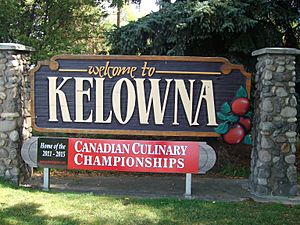
- Prospera Place: A large indoor arena with 6,800 seats.
- Apple Bowl: An outdoor stadium with 2,314 seats.
- Elks Stadium: An outdoor baseball stadium with 1,250 seats.
- Kelowna Art Gallery: A place to see amazing art.
- Centre of Gravity Festival: A fun festival held in City Park.
- Kettle Valley Railway (Myra Canyon Trestles): Historic railway bridges that are great for walking and biking.
- Big White Ski Resort: A popular place for skiing and snowboarding.
- Okanagan Wineries: Many vineyards where you can learn about and taste local wines.
Culture and Sports in Kelowna
- Westbank First Nation: The local Indigenous community.
- Kelowna Rockets: A major junior hockey team that won the 2004 Memorial Cup.
- Kelowna Chiefs: A junior B hockey team.
- Okanagan Sun: A Canadian Junior Football League team that won the Canadian Bowl in 1988 and 2000.
- Kelowna Falcons: A collegiate baseball team.
- Okanagan Independent Film Festival: A festival showcasing independent films.
- World Community Film Festival: A festival focused on films about global issues.
Learning in Kelowna: Education
Colleges and Universities
- University of British Columbia, Okanagan Campus
- Okanagan College
- Focus College
- Justice Institute of British Columbia (Okanagan Campus)
- Sprott Shaw College (private)
- The Centre for Arts and Technology (private)
- VanWest College (private)
Schools for Kids
Public schools in Kelowna are part of School District 23 Central Okanagan.
- Secondary Schools (grades 10–12 or 8–12):
- Kelowna Secondary School (offers French immersion)
- Rutland Senior Secondary School
- Mount Boucherie Senior Secondary School
- Okanagan Mission Secondary School
- George Elliot Secondary School
- Central School − Central Programs & Services: Alternative High School
The Conseil scolaire francophone de la Colombie-Britannique operates one French-language school: école de l'Anse-au-sable (for primary and secondary students).
Private Schools
- Aberdeen Hall Preparatory School (pre-school, K−12)
- Kelowna Christian School (Pre-12)
- Heritage Christian School (K−12)
- Studio 9 School of The Arts (preschool−11)
- Okanagan Adventist Academy (pre−12)
- Immaculata Regional High School (8–12)
- St. Joseph Elementary (K−7)
- Kelowna Waldorf School (pre−8)
- Okanagan Montessori School (preschool and kindergarten)
- Willowstone Academy (pre-school, K–9)
Public Libraries
The Okanagan Regional Library has three branches in Kelowna:
- Kelowna Branch (Downtown)
- Rutland Branch
- Mission Branch
- UBCO Branch
Famous People from Kelowna
Politicians
- W. A. C. Bennett: A former Premier of British Columbia.
- William R. Bennett: Also served as Premier of the province.
Military
- Charles Thomas: A high-ranking officer in the Canadian military.
Athletes
Many athletes have come from Kelowna, including:
- Steve Bozek: Professional ice hockey player.
- Aleisha Cline: Cross skier and Winter X Games medalist.
- Byron Dafoe: Professional ice hockey player.
- Scott Frandsen: Olympic rower.
- Rob Friend: Professional football (soccer) player.
- Josh Gorges: Professional ice hockey player.
- Tij Iginla: Ice hockey player, picked 6th overall in the 2024 NHL draft.
- Rory MacDonald: Professional Mixed Martial Arts fighter.
- Taylor Ruck: Olympic swimmer.
- Justin Schultz: Professional ice hockey player.
- Kelsey Serwa: Gold medal Olympic ski cross athlete.
- Kierra Smith: Olympic swimmer.
- Danny Watkins: Professional football player.
Entertainers
- Chad Brownlee: Country music artist.
- Conro: DJ and music producer.
- Excision: DJ and music producer.
- Jillian Harris: Television personality.
- Taylor Hickson: Actress and singer-songwriter.
- Paul Johansson: Actor.
- Taylor Kitsch: Actor and model.
- Evangeline Lilly: Actress and model.
- Twistzz: Professional video game player for Team Liquid.
Authors
- Fern G. Z. Carr
- Melonie Dodaro
- Alix Hawley
- Naben Ruthnum
- Jack Whyte
Sister Cities
Kelowna has "sister city" agreements with other cities around the world. This helps build friendships and cultural exchange.
Freedom of the City
The "Freedom of the City" is a special honour given to individuals or military units who have made important contributions to Kelowna.
Individuals Honoured
- Brigadier General Harry Herbert "H.H." Angle: January 7, 1946.
- Barbara Ann Scott: October 24, 1949.
- The Honourable W. A. C. Bennett: December 8, 1952.
- Major General, The Honourable George Randolph Pearkes: April 24, 1967.
- Blair Horn: September 11, 1984.
- The Honourable William Richards "Bill" Bennett: November 1, 1988.
- Senator, The Honourable D. Ross Fitzpatrick: May 26, 2008.
- Walter Gray: April 25, 2015.
- Andre Blanleil: April 25, 2015.
- Robert Hobson: April 25, 2015.
Military Units Honoured
- The British Columbia Dragoons: February 11, 1963.
Images for kids
See also
 In Spanish: Kelowna para niños
In Spanish: Kelowna para niños


